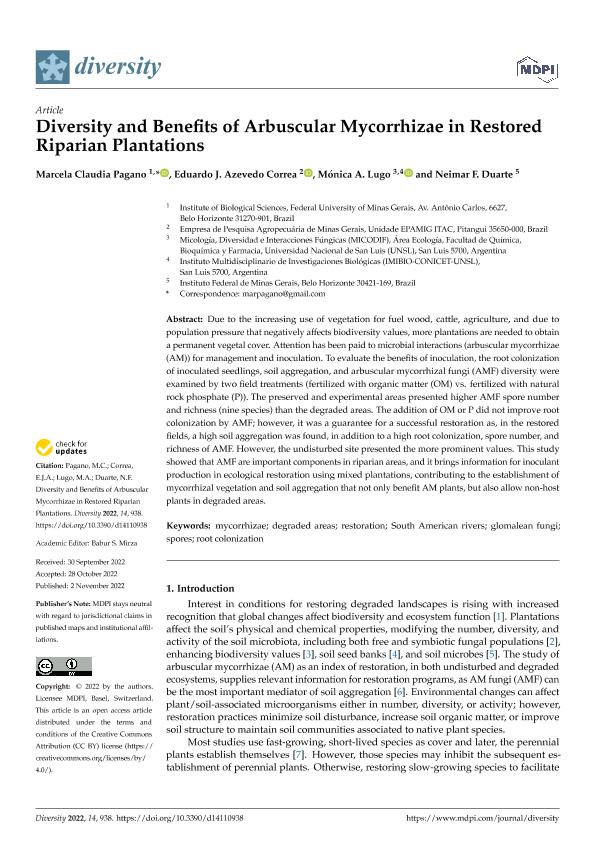Mostrar el registro sencillo del ítem
dc.contributor.author
Pagano, Marcela
dc.contributor.author
Azevedo Correa, Eduardo J.
dc.contributor.author
Lugo, Mónica Alejandra

dc.contributor.author
Duarte, Neimar F.
dc.date.available
2023-10-17T13:53:54Z
dc.date.issued
2022-11
dc.identifier.citation
Pagano, Marcela; Azevedo Correa, Eduardo J.; Lugo, Mónica Alejandra; Duarte, Neimar F.; Diversity and Benefits of Arbuscular Mycorrhizae in Restored Riparian Plantations; MDPI; Diversity; 14; 11; 11-2022; 1-14
dc.identifier.issn
1424-2818
dc.identifier.uri
http://hdl.handle.net/11336/215174
dc.description.abstract
Due to the increasing use of vegetation for fuel wood, cattle, agriculture, and due to population pressure that negatively affects biodiversity values, more plantations are needed to obtain a permanent vegetal cover. Attention has been paid to microbial interactions (arbuscular mycorrhizae (AM)) for management and inoculation. To evaluate the benefits of inoculation, the root colonization of inoculated seedlings, soil aggregation, and arbuscular mycorrhizal fungi (AMF) diversity were examined by two field treatments (fertilized with organic matter (OM) vs. fertilized with natural rock phosphate (P)). The preserved and experimental areas presented higher AMF spore number and richness (nine species) than the degraded areas. The addition of OM or P did not improve root colonization by AMF; however, it was a guarantee for a successful restoration as, in the restored fields, a high soil aggregation was found, in addition to a high root colonization, spore number, and richness of AMF. However, the undisturbed site presented the more prominent values. This study showed that AMF are important components in riparian areas, and it brings information for inoculant production in ecological restoration using mixed plantations, contributing to the establishment of mycorrhizal vegetation and soil aggregation that not only benefit AM plants, but also allow non-host plants in degraded areas.
dc.format
application/pdf
dc.language.iso
eng
dc.publisher
MDPI

dc.rights
info:eu-repo/semantics/openAccess
dc.rights.uri
https://creativecommons.org/licenses/by/2.5/ar/
dc.subject
DEGRADED AREAS
dc.subject
GLOMALEAN FUNGI
dc.subject
MYCORRHIZAE
dc.subject
RESTORATION
dc.subject
ROOT COLONIZATION
dc.subject
SOUTH AMERICAN RIVERS
dc.subject
SPORES
dc.subject.classification
Micología

dc.subject.classification
Ciencias Biológicas

dc.subject.classification
CIENCIAS NATURALES Y EXACTAS

dc.title
Diversity and Benefits of Arbuscular Mycorrhizae in Restored Riparian Plantations
dc.type
info:eu-repo/semantics/article
dc.type
info:ar-repo/semantics/artículo
dc.type
info:eu-repo/semantics/publishedVersion
dc.date.updated
2023-10-12T11:28:54Z
dc.journal.volume
14
dc.journal.number
11
dc.journal.pagination
1-14
dc.journal.pais
Suiza

dc.journal.ciudad
Basilea
dc.description.fil
Fil: Pagano, Marcela. Universidade Federal de Minas Gerais; Brasil
dc.description.fil
Fil: Azevedo Correa, Eduardo J.. Universidade Federal de Minas Gerais; Brasil
dc.description.fil
Fil: Lugo, Mónica Alejandra. Consejo Nacional de Investigaciones Científicas y Técnicas. Centro Científico Tecnológico Conicet - San Luis. Instituto Multidisciplinario de Investigaciones Biológicas de San Luis. Universidad Nacional de San Luis. Facultad de Ciencias Físico Matemáticas y Naturales. Instituto Multidisciplinario de Investigaciones Biológicas de San Luis; Argentina. Universidad Nacional de San Luis. Facultad de Química, Bioquímica y Farmacia; Argentina
dc.description.fil
Fil: Duarte, Neimar F.. Universidade Federal de Minas Gerais; Brasil
dc.journal.title
Diversity

dc.relation.alternativeid
info:eu-repo/semantics/altIdentifier/doi/https://doi.org/10.3390/d14110938
Archivos asociados
